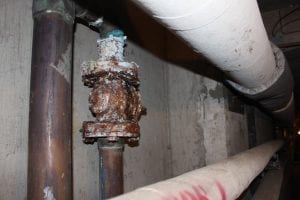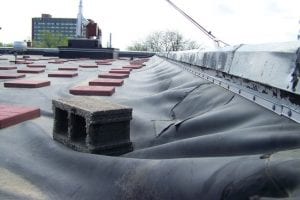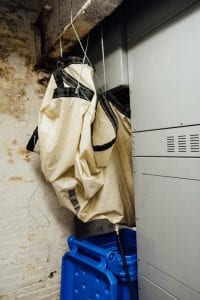The Wall Street Journal article reprinted below discusses the deferred maintenance dilemma affecting many U.S. colleges. At SUPERSTRUCTURES, we’re assisting NYC colleges prioritize and judiciously deploy funds for building envelope projects. We’re working with Columbia, NYU, Fordham, and each of the 24 campuses of the City University of New York.
By Melissa Korn
June 5, 2017
Lurking inside the ivy-covered gothic towers and brutalist concrete blocks on college campuses are moldy ceilings, failing plumbing and antique boilers whose replacement parts are available only on eBay.
Still reeling from state funding cuts and battered endowments in the wake of the financial crisis, U.S. universities have been putting precious money toward financial aid, academic programs and gleaming buildings that might attract new students—neglecting aging electrical systems and leaky roofs. As a result, schools are staring down a deferred maintenance backlog that has topped $40 billion, by some estimates, more than the federal government spends on Pell Grants for needy college students each year.
Despite adding student fees for facilities and even demolishing buildings that are beyond repair, the campus To Do lists continue to grow as buildings push 60 years old. For schools already under financial pressure, a burst pipe could spell disaster.
The tab for deferred maintenance at the California State University System’s 44 million square feet of academic buildings is $2.6 billion, while the City University of New York has earmarked upward of $3 billion in “critical” maintenance needs over the next five years. Small private schools like New England College in New Hampshire peg their repair backlogs at roughly the same size as their endowments.
A recent report by Sightlines, a facilities advisory firm, found that the deferred maintenance backlog at colleges nationwide topped $100 per gross square foot of space in 2015, up from $81.72 in 2007.

When ticking off the issues that keep them awake at night, school presidents regularly include upkeep of aging facilities alongside concerns about regulatory compliance and program affordability. For David Anderson at St. Olaf College in Minnesota, it is about fulfilling a fiduciary responsibility because the campus’s physical assets are worth nearly a quarter-billion dollars. Les Wong at San Francisco State University has buildings averaging 50 years old, in an earthquake-vulnerable region.
“It’s like Whac-A-Mole,” said Gregg Goldman, chief financial officer at the University of Arizona, using the arcade mallet game to illustrate how new emergencies pop up right as others are fixed.
That school has roughly $350 million in deferred maintenance needs, including old roofing and heating, ventilation and air-conditioning systems that work overtime in the Tucson desert. Mr. Goldman called the backlog a “ticking time bomb” at a November Board of Regents meeting.
Last summer, a transformer in a 50-year-old research building failed; another caught fire as maintenance staff looked into the problem, forcing employees there and patients at an attached hospital to evacuate. The school found a replacement fuse on eBay.

The University of Illinois at Urbana-Champaign has resorted to using bricks to weigh down rubber and plastic membranes that wick water from the roof, said Doris Reeser, assistant director of capital programs. While building tops aren’t “flapping in the wind” that way, Ms. Reeser said, rain may still get on some research, like at the National Soybean Research Laboratory, where parts of the 99,000-square-foot building also have no ventilation or chilled water.
Private schools also struggle with the issue, in part because donors are more likely to open their wallets for a new building than for upgraded plumbing.
A basement office for roughly a dozen Ph.D. students at New York University has fresh carpets and cheery yellow-green walls. It also has a tarp protecting an electrical closet from incessant leaks and ceiling tiles that have turned brown from water damage.
A school spokesman said that NYU doesn’t own all the buildings it occupies, and has to work with landlords for some repairs. He acknowledged that much of the school’s building stock is old, but noted that the school has trimmed its deferred-maintenance backlog by $200 million between 2013 and 2016, but declined to say where it stands now.
Hamilton College in Clinton, N.Y., will break ground this summer on a health services and counseling facility. Three years ago, it completed a $47 million theater and studio arts center with space for woodworking and a recording studio.

But the school’s deferred-maintenance backlog is roughly $85 million, and while it is replacing a half-dozen roofs and renovating three small dorms in coming months, Hamilton still puts just $6 million a year into plant renewal—half of what an outside consultant recommends.
The median capital spending ratio at private colleges and universities nationwide was 1.29 in fiscal 2015, meaning that schools invested enough money to cover depreciation on existing facilities plus about 30% more. That is the lowest in at least a decade, according to Moody’s Investors Service, and schools with weak credit ratings put in only 83 cents for every dollar of depreciation.
To chip away at its half-billion-dollar mountain of repairs, the University of North Dakota is raising tuition next year, with roughly $1 million a year directed to a new capital pool. Other schools have instituted student fees for maintenance.
And Wells College in Aurora, N.Y., plans to offer naming rights on dorm rooms when it launches a capital campaign next year. The ’Room with a View’ project would put $10,000 of new heating, windows and flooring into each living space.
Meanwhile, the University of Arizona may have defused its time bomb—for now. Gov. Doug Ducey approved a budget last month that lets the university issue $200 million in debt for repairs, and almost as much for the construction of new research facilities.
Up first with the new funds is the veterinary science and microbiology building. Mr. Goldman said he hopes to get the $18 million overhaul started as soon as next month.
14 Wall Street, 25th Floor, New York, NY 10005
(212) 505 1133
info@superstructures.com
Subscribe to SuperScript, our email newsletter.